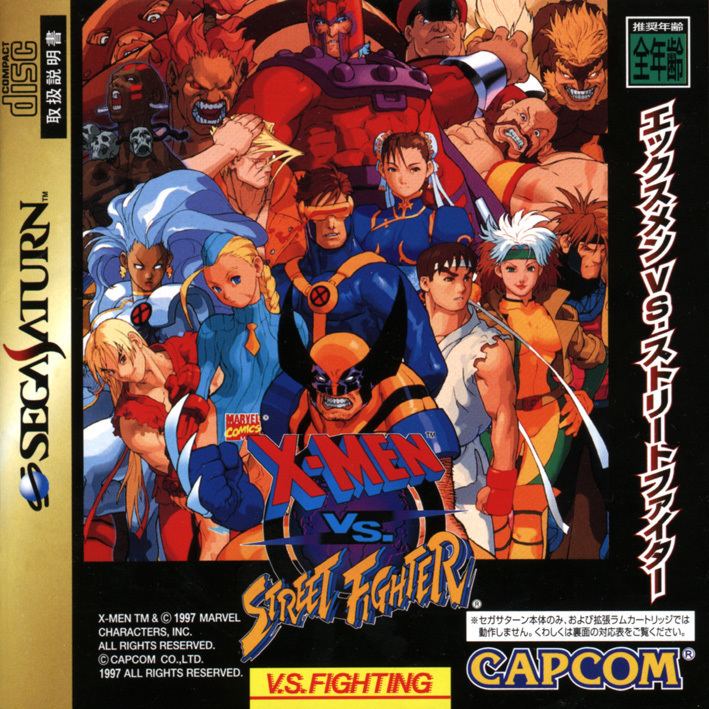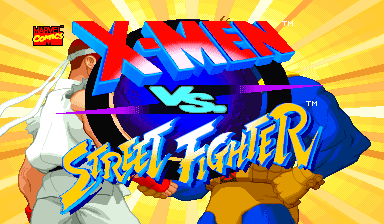9.6 /10 2 Votes
4.5/5 gamesra Producer(s) Tetsuya Iijima Cabinet Upright Sound QSound | 4.7/5 Emuparadise Initial release date 9 September 1996 Developer Capcom | |||||||||||||||||||||||||||||||||
 | ||||||||||||||||||||||||||||||||||
Composer(s) Yuki IwaiYuko Takehara Mode(s) Single-player, multiplayer Similar Marvel Super Heroes v, X‑Men: Children of the Atom, Marvel vs Capcom: Clash of, Street Fighter Alpha 2, Street Fighter Alpha | ||||||||||||||||||||||||||||||||||
X men vs street fighter marvel vs capcom legacy part 3 online matches
X-Men vs. Street Fighter (Japanese: エックスメン VS. ストリートファイター, Hepburn: Ekkusu Men bāsasu Sutorīto Faitā) is a crossover fighting video game developed and published by Capcom. It is Capcom's third fighting game to feature Marvel Comics characters, following X-Men: Children of the Atom and Marvel Super Heroes, and the first installment in the Marvel vs. Capcom series. As the title suggests, the game includes characters from Marvel's X-Men franchise and the cast from Capcom's Street Fighter series. Originally released as a coin-operated arcade game in 1996, it was eventually ported to the Sega Saturn in 1997 and the PlayStation in 1998.
Contents
- X men vs street fighter marvel vs capcom legacy part 3 online matches
- Zangiefinite x men vs street fighter online matches
- Gameplay
- Modes
- Playable characters
- Development and release
- Reception
- Sequel
- References

X-Men vs. Street Fighter features gameplay similar to Street Fighter, but incorporates dual-character selection and tag team-based combat. Each player selects two characters to compete in a one-on-one battle, attempting to defeat the opposing team. The players are given the ability to switch between their characters at any point during the match. The game also incorporates numerous elements from X-Men: Children of the Atom and Marvel Super Heroes.

The game was released to generally positive reviews, with critics praising its gameplay and sprite animation quality. While the Sega Saturn port received praise for maintaining the experience of the original arcade version, the PlayStation port was met with mixed to negative critical reception for removing several features, such as tag team battles. The changes were done in response to the technical limitations of the PlayStation. A sequel to the game, Marvel Super Heroes vs. Street Fighter, was released in 1997.

Zangiefinite x men vs street fighter online matches
Gameplay
Similar to Capcom's various Street Fighter titles, X-Men vs. Street Fighter is a 2D fighting game in which players control various characters to engage in one-on-one combat, attempting to knock out the opponent by depleting their health. It is the first formal installment in the Marvel vs. Capcom series and features dual-character selection and tag team battles. Instead of the typical best-of-three round format, matches consist of a single round. Players select two characters at the beginning of a match, each sporting their own life gauge. Players control one character at a time, while the other awaits off-screen. The starting character can tag in the off-screen character at any time during the fight. The dormant character will also slowly recover a portion of their vitality while the current character is fighting. If one character loses all of their vitality, then the tag partner will automatically come into play. The match continues until both characters on either team are defeated. If the timer runs out before either team is knocked out, then the player with the most remaining health is declared the winner.
The game borrows numerous gameplay conventions from Capcom's previous Marvel-licensed ventures, X-Men: Children of the Atom and Marvel Super Heroes, such as the "Super Jump", the ability to jump higher than normal, and "Aerial Rave", the ability to perform combos on the opponent while in the air. X-Men vs. Street Fighter also includes a meter system similar to the two aforementioned games called the "Hyper Combo Gauge". As characters perform moves and receive damage, the players' Hyper Combo Gauges will gradually fill. Players can expend their meter to perform various special techniques, such as the "Hyper Combo", which unleashes high amounts of damage; "Variable Combination", where both characters use their Hyper Combos simultaneously; and "Variable Counter", which transforms a defensive block into an offensive counterattack by tagging in the off-screen character.
Modes
The arcade, Sega Saturn, and PlayStation versions of X-Men vs. Street Fighter all include Arcade Mode and Versus Mode. In Arcade Mode, the player fights several artificial intelligence-controlled teams before competing in a final battle against the boss character, Apocalypse, an antagonist from the X-Men series. In Versus Mode, two players can fight against each other locally. The PlayStation port also features Training Mode, where players can practice moves and combos against non-aggressive computer opponents, and Survival Mode, where players fight against endless waves of teams.
Playable characters
X-Men vs. Street Fighter features a roster of 17 playable characters. The character sprites for the X-Men characters were drawn from X-Men: Children of the Atom, with the exception of Rogue, Gambit, and Sabretooth, who had not appeared in a previous Capcom fighting game. The sprite designs themselves are based on the characters' appearances from the 1990s animated X-Men television series, complete with the original voice actors. The Street Fighter character sprites are reused from Street Fighter Alpha 2. Similar to his secret guest appearance in Children of the Atom, Akuma appears as a hidden character in X-Men vs. Street Fighter. In order to create a level playing field between the cast of Street Fighter and the X-Men series' superheroes and supervillains, the Street Fighter characters were re-imagined with highly exaggerated versions of their special moves. For example, Ryu comes equipped with a "super Hadouken" that fills the entire screen.
Development and release
X-Men vs. Street Fighter debuted in Japan in September 1996 for the CP System II arcade board, and was released worldwide later on in 1996. The game received a port to the Sega Saturn in Japan on November 27, 1997. The port utilized the Saturn's 4MB RAM cartridge peripheral, which was packaged alongside the game, to deliver an arcade-perfect conversion. It was not officially released in North America due to the Saturn's low sales numbers in the North American market. An imported version was sold at certain Electronics Boutique locations. Sega had initially intended to release the game in Europe bundled with the expansion cartridge; however, these plans were eventually shelved. The game was then ported to the PlayStation on February 26, 1998 in Japan, where it was renamed X-Men vs. Street Fighter: EX Edition. The PlayStation port was also released in North America on June 11, 1998, and Europe in November 1998.
Due to the memory limitations of the PlayStation, both the graphics and gameplay of the port were altered. Several frames of character sprite animations were removed to reduce the amount of RAM usage. Most notably, the tag team combat was omitted. Instead of being able to switch between characters at will, the second character only comes into play during certain attacks, such as Variable Combinations and Variable Counters. In addition, the one-round battles used in the arcade and Sega Saturn versions were extended to a two-out-of-three round setup. The PlayStation version includes a code that allows players to compete in "pseudo-tag team matches", provided that each player uses their opponent's starting character as their partner. For example, if Player 1 is controlling Ryu and Player 2 is controlling Wolverine, then Player 1's partner will be Wolverine and Player 2's partner will be Ryu.
Reception
The Sega Saturn edition of X-Men vs. Street Fighter received "favorable" reviews according to the review aggregation website GameRankings. Reviewers praised its fast-paced gameplay, animation and sound quality, and technical performance in comparison to the original arcade version. Jeff Gerstmann of GameSpot commended the character sprite animations and background details, claiming that "there is no better looking 2D fighter on any console system". While Gerstmann also praised the port for its fast loading times and lack of slowdown, he criticized the game for its defense-oriented gameplay and unoriginal soundtrack. Game Informer lauded the port for running and looking identical to its arcade counterpart, declaring it "one of the best arcade conversions ever seen to date".
The PlayStation version, on the other hand, received "mixed" reviews according to GameRankings. Many reviewers' critiques were centered on the port's various changes as a result of the PlayStation's technical restraints. Both GameSpot and Game Revolution lambasted the game for its removal of tag team battles and several instances of slowdown. The two sites also criticized the port's low frame rate and noticeable decline in animation quality. While Game Informer and IGN shared many of the same criticisms, they viewed the game from a more positive perspective. Both maintained that, while the PlayStation port paled in comparison to the Sega Saturn version, it was still a solid fighting game. As for the arcade version, AllGame gave it a score of four stars out of five.
Sequel
A sequel to X-Men vs. Street Fighter was released by Capcom in 1997. Marvel Super Heroes vs. Street Fighter, while similar in terms of gameplay and art style, replaces a majority of the X-Men cast with characters from other Marvel Comics properties, such as Captain America and Spider-Man. The game is notable for introducing "assists" into the Marvel vs. Capcom series, which allow players to summon their off-screen character to perform an attack during battle. Like X-Men vs. Street Fighter, the game was ported to the Sega Saturn and PlayStation, which were released in 1998 and 1999, respectively.
